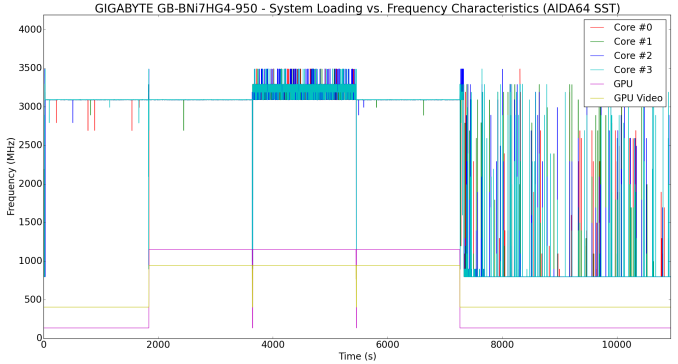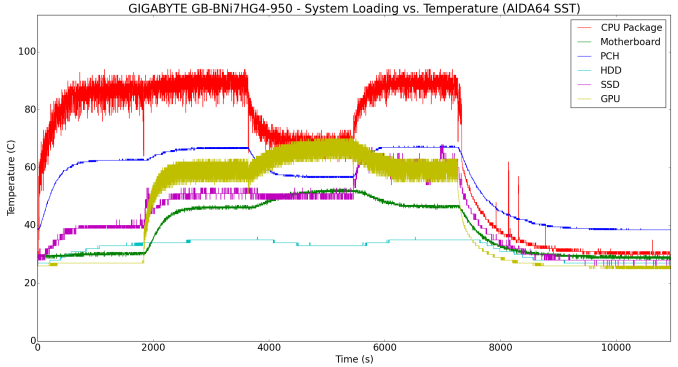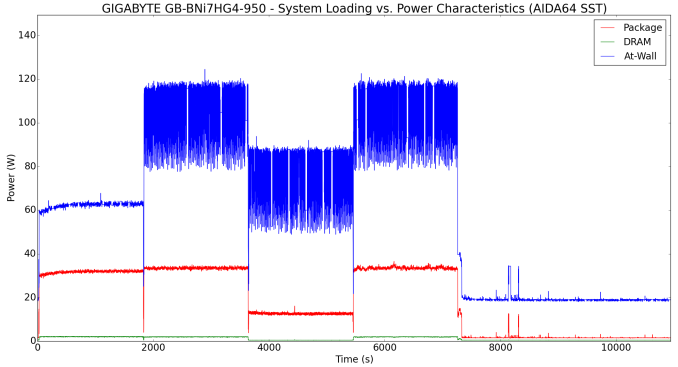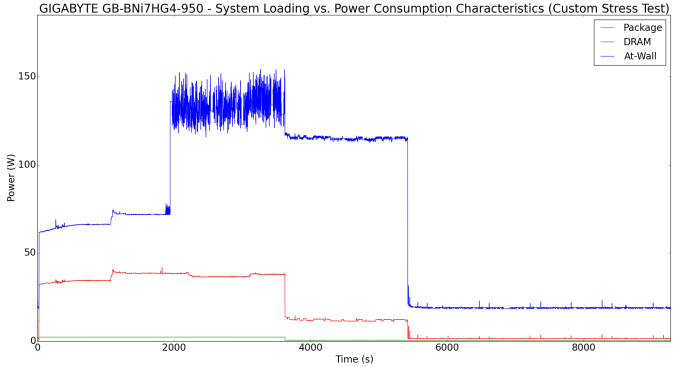GIGABYTE BRIX Gaming UHD GB-BNi7HG4-950 mini-PC Review
by Ganesh T S on October 28, 2016 7:30 AM ESTPower Consumption and Thermal Performance
The power consumption at the wall was measured with a 1080p display being driven through the HDMI port. In the graphs below, we compare the idle and load power of the GIGABYTE GB-BNi7HG4-950 with other gaming mini-PCs evaluated before. For load power consumption, we ran both our custom stress test and the AIDA64 System Stability Test with various stress components, and noted the maximum sustained power consumption at the wall.


The power consumption numbers tally well with the capabilities of the system.
Our thermal stress routine starts with the system at idle, followed by four stages of different system loading profiles using the AIDA64 System Stability Test (each of 30 minutes duration). In the first stage, we stress the CPU, caches and RAM. In the second stage, we add the GPU to the above list. In the third stage, we stress the GPU standalone. In the final stage, we stress all the system components (including the disks). Beyond this, we leave the unit idle in order to determine how quickly the various temperatures in the system can come back to normal idling range. The various clocks, temperatures and power consumption numbers for the system during the above routine are presented in the graphs below.
According to the official specifications, the junction temperature of the Core i7-6700HQ is 100C. We see that the temperature of the package is kept well below that number, without any throttling of the clocks. In order to make sure that we weren't overstimating the cooling capabilities of the system, we also processed our custom stress test that proesses a more strenuous workload for the GPU, RAM and the GPU (but, not the other parts of the system).
It is heartening to note that the thermal design is indeed very effective even in our unnatural power-virus test. The cores keep running at higher than the rated base clock (3.1 GHz instead of 2.5 GHz). The other interesting aspect is that the temperatures go down to below 30C for all the components in less than 30 minutes after the load is removed. The drives also maintain very reasonable temperatures in the system. On the whole, the thermal design of the unit is very impressive.
















50 Comments
View All Comments
TheinsanegamerN - Tuesday, November 1, 2016 - link
well, size wise, the brix wins hands down. That isnt even up for debate.Samus - Wednesday, November 2, 2016 - link
I can't not look at the thing and just think Gigabyte was clearly inspired by the Silverstone FT03-mini with this thing.They made a "mini" FT03-mini.
fanofanand - Friday, October 28, 2016 - link
$1160 with single channel RAM. Dumb dumb dumb dumb dumb.ganeshts - Friday, October 28, 2016 - link
That was the review configuration supplied. It is not limited by design, so the end-user can always add an additional SODIMM stick for around $50 or so.TheinsanegamerN - Tuesday, November 1, 2016 - link
at that price, dual channel should be included by default. My gaming laptop cost less then this thing.Lolimaster - Friday, October 28, 2016 - link
They know that once Raven Ridge ZEN APU arrives, any small pc with discrete gpu is done.hojnikb - Saturday, October 29, 2016 - link
not really. raven will be at best at performance levels of a rx460, so plenty of room therewintermute000 - Saturday, October 29, 2016 - link
yeah but enough to make a GTX950 irrelevant IF that is the caseThe_Assimilator - Saturday, October 29, 2016 - link
GTX 950 is already irrelevant thanks to GTX 1050... which beats RX 460... which makes Raven Ridge obsolete before it's ever launched. Seems like a common theme for AMD.meorah - Friday, October 28, 2016 - link
gtx 1050 ti review anytime soon?